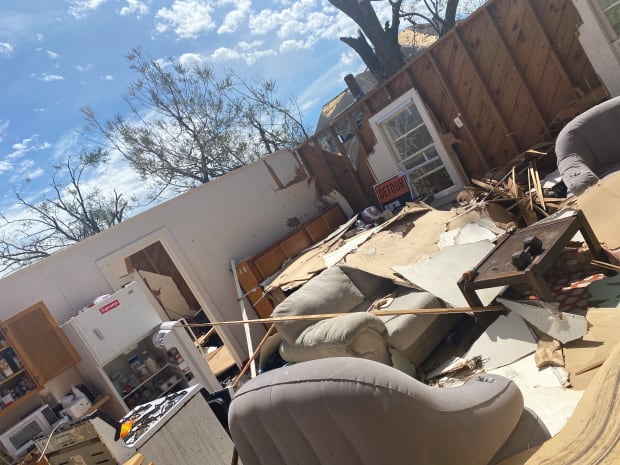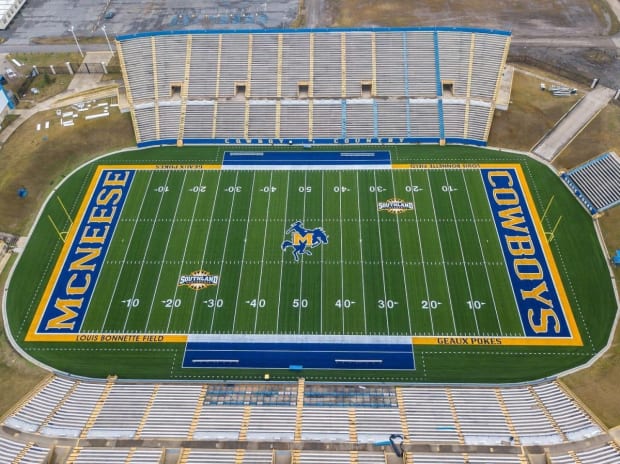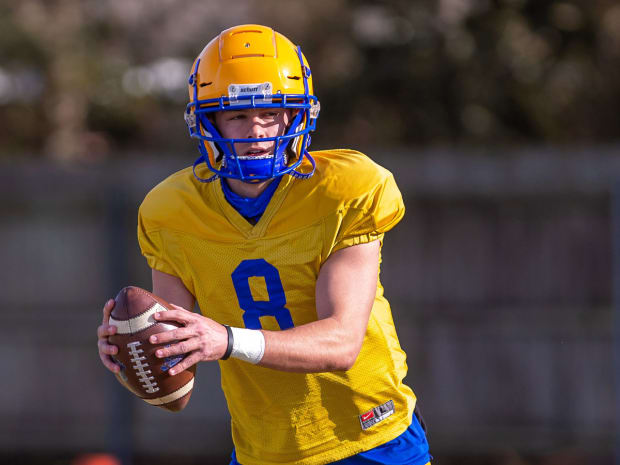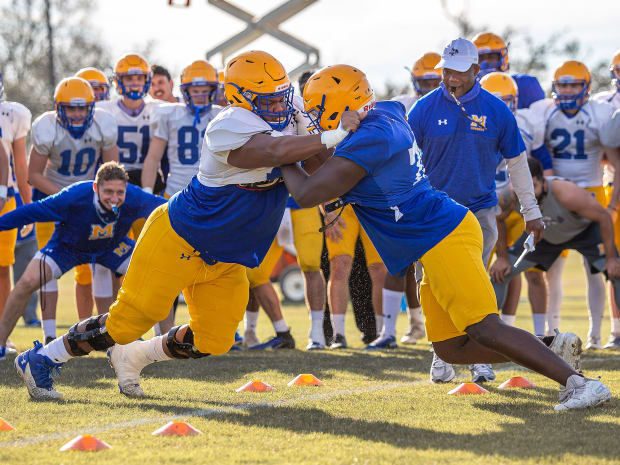The Cowboys will open the FCS spring football season less than six months after a hurricane left their campus in its wake.
Isaiah Chambers has received plenty of horrifying phone calls in the 22 years he’s been on this earth.
When he was in junior high, Isaiah’s mother, while picking him up from football practice, passed out in the driver’s seat of their parked car. At first told she’d be O.K., Isaiah got the message later that his mom had died of a heart-related issue.
In 2018, halfway through his redshirt sophomore season at Houston, he injured his knee. Doctors later told him that he’d miss the rest of the year. Last year, amid the COVID-19 pandemic and a few months after arriving at his third college in five years, Isaiah learned that his father had died.
And then in late August 2020, while home in Houston after evacuating from southwest Louisiana as a hurricane approached, his phone rang with another dose of grim news.
“Your roof is gone,” his landlord told him. “Better come get your stuff so it doesn’t get wet.”

Chambers didn’t get there in time. He lost virtually all of his belongings—clothes, a piano, a television and even his birth certificate. They were blown away or ruined by rain when Hurricane Laura roared ashore in Lake Charles, La., devastating the community and its local college, McNeese State.
More than five months later, Chambers, a defensive lineman on McNeese’s football team, has since replaced some of those items. He’s got a new TV, some new clothes and is clinging to his high school letterman jacket, one of the few items he saved from the wreckage. “I started fresh pretty much,” he says.
The six-foot-five, 250-pound senior embodies this community, this college and this football team. Blown away by one hurricane’s winds and washed away by another hurricane’s torrential rains (Delta hit six weeks after Laura), they’ve emerged from a literal and figurative heap of debris to, appropriately enough, kick off the FCS’s unprecedented spring football season.
The McNeese State Cowboys play Tarleton State on Saturday night in Stephenville, Texas, and host their first game at their restored home stadium on Feb. 27.
Lake Charles, McNeese State and Cowboys football are back.
“I don’t want to be shallow, but to be able to kick off is a victory for us,” says football coach Frank Wilson. “Many left us for dead. They ain’t playing this year! There’s still a long way to go. Roofs are still being put back together. We’re working in our building while we have people working on our building. But there’s light at the end of the tunnel.”

The Cowboys will play this weekend, down 21 players from the time Wilson took over as head coach last January, half of whom transferred after Laura destroyed the area. Because of COVID-19, they held no spring practice, very little summer training and didn’t have a single, full-padded fall camp practice in August before the storm arrived. During the months of September and October, players and staff members were scattered across the country, many of their Lake Charles homes uninhabitable.
When they returned to campus in November, most of them stayed at a Marriott hotel, occupying more than 80% of rooms. Players and coaches have slowly moved back into their homes. Even still, a handful of players will remain at the hotel until the contract ends on Feb. 15.
And then, just as game-planning began last week for their first game, Wilson’s defensive coordinator left for a more lucrative gig with the University of Houston. As if they hadn’t fought through enough challenges.
“Sorry,” Wilson said from the other end of the phone during an interview, “I’m scrambling.”
The hurdles never end.
Using FaceTime, Wilson walked through the team’s partially renovated fieldhouse, which months before was a moldy, water-logged den. He then stepped outside into a football stadium that took the brunt of Laura’s 130-plus mph winds.
Today, new iron fencing guards the exterior. The goalposts, bent by Laura, have been replaced with shiny new ones. A new scoreboard is nearing completion, and a brand-new, artificial turf field is shimmering in the sunlight.
“It’s a beautiful thing,” Wilson says, “but there are reminders of what happened here.”
Take, for example, the pair of deep holes dug into the grass beyond one end zone. That’s where a portion of the fieldhouse collapsed. The steel light poles that once towered over the stadium have been removed after being mangled in Laura’s winds. (Home games this spring will be played during the day.) The stadium press box is not operational and will be demolished after the season. In fact, the TV replay booth for this year is stationed inside the field house, within an assistant coach’s office overlooking the field.
Wilson walks back inside. With the team meeting room unfinished, he holds meetings from the stadium’s club level, an expansive, bright room on the top floor of the field house. He’s taped material against its giant windows to darken the room for film sessions.
They make do with what they’ve got. That goes for personnel, too. This fall, Wilson lost one of his best offensive linemen to Tulane and another standout player to Texas. Another departed for Hawaii. Players, fearing McNeese would not hold a spring season, bolted for a chance to play.
While rebuilding campus and the community, Wilson found himself recruiting players on his own team to stay.
“We started doing home visits,” he says. “People started cherry-picking our guys.”
Chambers, of course, stayed. He’s now living in his third different home since Laura destroyed his apartment. Chambers crashed with his aunt in Houston for much of the fall, spent most of November in that Marriott hotel and now has a new apartment in the city.
The former TCU and Houston defensive end, once a four-star prospect out of high school, is the quarterback of the defense. And the quarterback of the offense? That’s Cody Orgeron, son of LSU coach Ed Orgeron. They are a pair of heartbeats of a program that has for decades been a central rallying point for the Lake Charles community.

Somewhat of an FCS powerhouse, the Cowboys consistently lead the Southland Conference in attendance, hold the league record with 16 FCS playoff appearances and are on an FCS–record streak of 15 consecutive winning seasons.
“Our back has been against the wall,” Chambers says. “We’ve got a great story if we can make it happen. Our goal is to go 7–0.”
Win or lose, the return of football is a seminal moment in a region of the country that often bathes itself in the sport on autumn weekends. Now, they’ll do it in the spring. And it’ll be free, too. The school is not charging fans an admittance fee, but attendance is restricted. Due to COVID-19 protocols, it’s 5,000 in a 17,400-seat Cowboy Stadium, a concrete behemoth buried between giant mounds of earth. (They refer to it as The Hole.)
“We want to do this for the community,” says Daryl Burckel, the McNeese State president and a former middle linebacker for the Cowboys. “We want fans to get away from the grind and bring your families and come experience this.”
Burckel has been the leader of recovery efforts that have been so swift they’ve shocked locals. He is a Louisianan through and through, from his Cajun accent to his office decor. On his desk are unopened bottles of the school’s own line of distilled liquor, Geaux Pokes vodka.
He bubbles with optimism, a true glass-half-full kind of guy. And with good reason. His community and campus withstood the 10th-strongest hurricane to hit the mainland U.S. Five months later, 13 of 16 sports will host games this spring at their own facilities. Roughly 50% of dorms are operational. Football, baseball and softball have new turf fields.
“To me, it’s a miracle, because I saw what it was,” says Matthew Bonnette, the school’s longtime sports information director.
But not everything is rosy.
While schools across the country are battling financial deficits for COVID-19–related reasons, McNeese is in a deeper hole created by both the pandemic and the storms. Enrollment is down by about 15%, costing the school roughly $3 million. The damage cost, by the end of renovations, could total as much as $200 million. The school has already spent $100 million, much of it from state funds, insurance payments and FEMA.
McNeese is having to supply some of the costs up-front before being reimbursed.
“We’re starting to have cash flow issues,” Burckel says. “In the future, the budget is going to be a big issue. After [Hurricane] Rita [in 2005], it took five years to come back and start progressing. There will be a prolonged recovery period.”
All around campus, reminders of the destruction dot the city. Many homes are not inhabitable. They are easy to spot—the ones with a camper or trailer out front. Bonnette, in fact, spent 161 days living in a 38-foot camper with his wife while partially rebuilding his damaged home. Last Wednesday, he got to sleep in his own bed for the first time since Aug. 24.
Burckel is living in the on-campus president’s home while his house undergoes renovations for water damage. While Laura brought the wind, Delta brought the rain. The latter roared ashore during the recovery process for the former.
“What damage you didn't see from Laura, Delta came back and assured you that you have a leak or a crack,” Wilson says. “It poured thousands of gallons of water on us. It tested your faith. You ask God, ‘What is it? What are you trying to tell me here?’ ”
The school’s two-year-old, $44 million health and human performance complex took the worst of the damage. Laura ripped a giant hole in the complex, which houses classrooms, coaches’ offices, a state-of-the-art basketball arena and practice facility. Delta then dumped 16 more inches of rain into the arena, rendering it useless this season. The volleyball and basketball teams are playing elsewhere.
Burckel says the arena’s renovation will start in April and should be ready next winter. He’s set a new optimistic goal for the entirety of campus: all academic buildings fully restored by the summer for in-person classes.
It seems like a steep climb. But so was this.
The march to this point seems even more incredible given the football team’s academic reversal. The Cowboys posted a 3.1 GPA last fall, a semester after the NCAA levied harsh academic sanctions against the program, banning it from the postseason this spring after it failed to meet Academic Progress Rate scores.
Given the circumstances and last semester’s GPA, Burckel has penned a letter to the NCAA petitioning the organization to waive the postseason ban.
“The young men have endured and persevered,” he says. “They’re exceeding expectations and have made great strides.”

Meanwhile, down the road at the McNeese baseball park, academics are even better. The baseball team posted a 3.4 GPA and none of the 46 players on coach Justin Hill’s roster left the team. That’s quite an accomplishment for a group of players who spent much of the fall couch surfing or sleeping on air mattresses after their apartments were destroyed.
The baseball park received just as much of Laura’s wrath as the football stadium. The grandstand remains inoperable and so is the team’s clubhouse. A giant tent, equipped with lighting and heat and erected down the right field foul line, will serve as a locker room.
At times, Hill feels helpless. Each time one task is accomplished, he notices another.
“We had an umpire come to do an intrasquad [scrimmage],” Hill says. “He goes, ‘This place looks terrible.’ I said, ‘You should have seen it before.’ ”
Back at football, Chambers is at his new apartment following a camp practice in, of all months, February. He’s excited about starting the season, taking the field and washing away many of the memories of last fall.
He feels the Cowboys are destined for greatness. He’s not sure he’s been on a team with a closer bond, and why shouldn’t it be this way? They shared a hotel for the better part of three months, eating each night in the hotel lobby and then quarantining in their rooms with video games, schoolwork and football. While the McNeese field house underwent repairs, the school set up a quasi–locker room at a local gymnasium and players lifted weights at a local high school.
They’ve been through the wringer, these guys. Chambers knows of some players who lost their grandparents to COVID-19 and lost their homes to the hurricane.
“We all became appreciative. Football taken away. Workouts taken away. Our homes taken away. Our building taken away,” he says. “We aren’t complaining anymore. Our guys are willing to fight. We learned our guys can persevere.”
And so, on Saturday night in Stephenville, Texas, the McNeese State Cowboys will take the field in a most extraordinary situation. Not only does this season opener come on Feb. 13, but it happens five months after their lives were, quite literally, turned upside down.
The football game is only the start to a busy spring in Lake Charles.
Lake Charles, McNeese State and Cowboys football are back.
“I made a list of every sport,” says Bonnette. “We have about 175 events from now until the middle of May. We’re going to be stretched.”
He pauses.
“But there’s nothing we can’t handle right now,” he says. “Bring it on.”